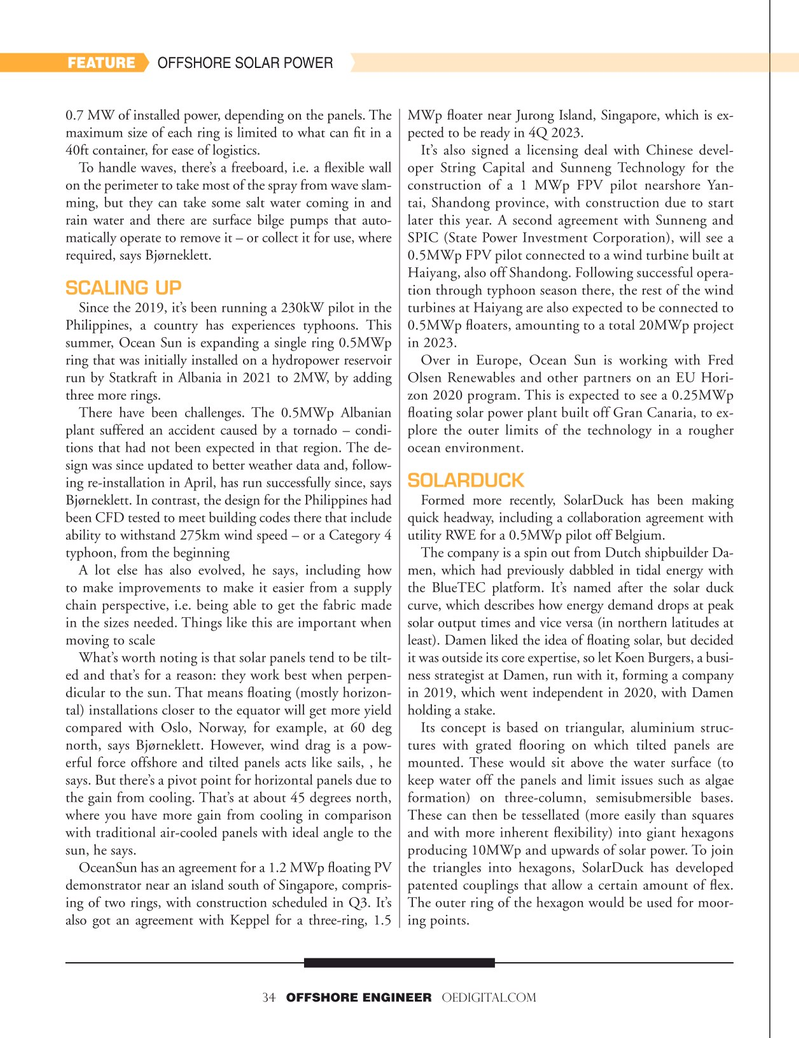
Page 34: of Offshore Engineer Magazine (Sep/Oct 2022)
Read this page in Pdf, Flash or Html5 edition of Sep/Oct 2022 Offshore Engineer Magazine
FEATURE OFFSHORE SOLAR POWER 0.7 MW of installed power, depending on the panels. The MWp foater near Jurong Island, Singapore, which is ex- maximum size of each ring is limited to what can ft in a pected to be ready in 4Q 2023.
40ft container, for ease of logistics. It’s also signed a licensing deal with Chinese devel-
To handle waves, there’s a freeboard, i.e. a fexible wall oper String Capital and Sunneng Technology for the on the perimeter to take most of the spray from wave slam- construction of a 1 MWp FPV pilot nearshore Yan- ming, but they can take some salt water coming in and tai, Shandong province, with construction due to start rain water and there are surface bilge pumps that auto- later this year. A second agreement with Sunneng and matically operate to remove it – or collect it for use, where SPIC (State Power Investment Corporation), will see a required, says Bjørneklett. 0.5MWp FPV pilot connected to a wind turbine built at
Haiyang, also off Shandong. Following successful opera-
SCALING UP tion through typhoon season there, the rest of the wind
Since the 2019, it’s been running a 230kW pilot in the turbines at Haiyang are also expected to be connected to
Philippines, a country has experiences typhoons. This 0.5MWp foaters, amounting to a total 20MWp project summer, Ocean Sun is expanding a single ring 0.5MWp in 2023.
ring that was initially installed on a hydropower reservoir Over in Europe, Ocean Sun is working with Fred run by Statkraft in Albania in 2021 to 2MW, by adding Olsen Renewables and other partners on an EU Hori- three more rings. zon 2020 program. This is expected to see a 0.25MWp
There have been challenges. The 0.5MWp Albanian foating solar power plant built off Gran Canaria, to ex- plant suffered an accident caused by a tornado – condi- plore the outer limits of the technology in a rougher tions that had not been expected in that region. The de- ocean environment.
sign was since updated to better weather data and, follow-
SOLARDUCK ing re-installation in April, has run successfully since, says
Bjørneklett. In contrast, the design for the Philippines had Formed more recently, SolarDuck has been making been CFD tested to meet building codes there that include quick headway, including a collaboration agreement with ability to withstand 275km wind speed – or a Category 4 utility RWE for a 0.5MWp pilot off Belgium. typhoon, from the beginning The company is a spin out from Dutch shipbuilder Da-
A lot else has also evolved, he says, including how men, which had previously dabbled in tidal energy with to make improvements to make it easier from a supply the BlueTEC platform. It’s named after the solar duck chain perspective, i.e. being able to get the fabric made curve, which describes how energy demand drops at peak in the sizes needed. Things like this are important when solar output times and vice versa (in northern latitudes at moving to scale least). Damen liked the idea of foating solar, but decided
What’s worth noting is that solar panels tend to be tilt- it was outside its core expertise, so let Koen Burgers, a busi- ed and that’s for a reason: they work best when perpen- ness strategist at Damen, run with it, forming a company dicular to the sun. That means foating (mostly horizon- in 2019, which went independent in 2020, with Damen tal) installations closer to the equator will get more yield holding a stake. compared with Oslo, Norway, for example, at 60 deg Its concept is based on triangular, aluminium struc- north, says Bjørneklett. However, wind drag is a pow- tures with grated fooring on which tilted panels are erful force offshore and tilted panels acts like sails, , he mounted. These would sit above the water surface (to says. But there’s a pivot point for horizontal panels due to keep water off the panels and limit issues such as algae the gain from cooling. That’s at about 45 degrees north, formation) on three-column, semisubmersible bases. where you have more gain from cooling in comparison These can then be tessellated (more easily than squares with traditional air-cooled panels with ideal angle to the and with more inherent fexibility) into giant hexagons sun, he says. producing 10MWp and upwards of solar power. To join
OceanSun has an agreement for a 1.2 MWp foating PV the triangles into hexagons, SolarDuck has developed demonstrator near an island south of Singapore, compris- patented couplings that allow a certain amount of fex. ing of two rings, with construction scheduled in Q3. It’s The outer ring of the hexagon would be used for moor- also got an agreement with Keppel for a three-ring, 1.5 ing points. 34 OFFSHORE ENGINEER OEDIGITAL.COM

 33
33

 35
35